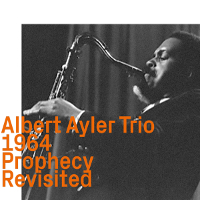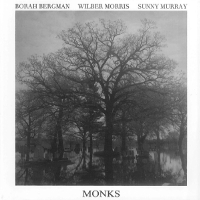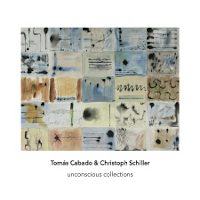Moment's Notice
Reviews of Recent Recordings
(continued)
Albert Ayler Trio 1964
Prophecy Revisited
ezz-thetics 1104
 In a time when the world has the opportunity to revisit much, it’s a real boon that the Revisited series keeps coming up with treasures from the 1960s. One look at the year here, and you know that it’s Ayler with bassist Gary Peacock and drummer Sunny Murray. Captured on June 14, 1964, at NYC’s Cellar Café, this is the primal source music, less than a month before the same trio would record the epochal Spiritual Unity.
In a time when the world has the opportunity to revisit much, it’s a real boon that the Revisited series keeps coming up with treasures from the 1960s. One look at the year here, and you know that it’s Ayler with bassist Gary Peacock and drummer Sunny Murray. Captured on June 14, 1964, at NYC’s Cellar Café, this is the primal source music, less than a month before the same trio would record the epochal Spiritual Unity.
Prophecy Revisited is a combination of two prior editions, now remastered and available together with only one alternate take lopped off. The music is, needless to say, beyond essential, and the Hat family of labels is to be commended for keeping it in circulation. Savoring this music is a particular treat since it distills, as Brian Olewnick points out in his excellent liner notes, a really remarkable transitional period that had been chopped apart by previous releases.
Historically, much has been made of the raw force of this music, its urgency and technical daring. Rightly so, given how much jaw-dropping innovation there is in Murray’s drumming for example, or in Ayler’s yawp on the opening “Spirits.” But what gets lost is just how much beauty and lyricism there was right from the beginning. You can really hear Peacock in detail here, his beautiful harmonic choices, his racing lines. And the sound wondrously captures Ayler in fierce form on tracks like “Wizard.” Murray remains some kind of miracle, his moans capturing the spectral essence as Ayler grunts here, dances rapidly into the firmament there. I’d forgotten about the near-swinging lilt on the first version of “Ghosts” here, which is simply excellent, and my rough old ESP can’t hold a candle to the crisp portrait here. The near-delicacy of Murray’s snare patterns, the complexity of the bass, the timbre of the horn as Ayler makes such unexpected, thrilling decisions, it remains as powerful as ever. Just listen to the sheer bass gravity and testifying quaver on “Prophecy” or the scalar undertow in the second version of “Ghosts.”
Some of you out there may be familiar with the remainder of the concert, issued at what Murray insists was the proper recording speed on the previous Albert Smiles with Sunny. Despite my love for Ayler, I’ll cop to never having heard these tunes. As if the new packaging and fidelity wasn’t enough to recommend this release! There’s an additional thirty-five minutes, with “Saints” and “Children” alongside further versions of “Ghosts” and “Wizard.” The sheer inventiveness of “Saints” and “Ghosts” here is astonishing, completely free and bursting with excitement. The latter has a long duo for Peacock and Murray that is honestly one of the best things I’ve ever heard from this trio. The whooping technique Ayler uses to open this version of “Wizard” is likewise fresh to my ears. And the gruff motif that anchors “Children” is balanced by some unexpected full pauses and dynamism; this really gives you a chance to luxuriate in Ayler’s tone and his rapturous melodic sense, the missing link between Chu Berry and Pharaoh. This music still has tremendous power, such that I can’t imagine how it landed in 1964. My, oh my.
–Jason Bivins
Borah Bergman + Wilber Morris + Sunny Murray
Monks
Some Real Music 005/6
 Well here’s a disc that will loosen the floorboards in your listening room. The confrontation of pianist Borah Bergman, the ultimate keyboard maximalist, and the compositions of Thelonious Monk, the ultimate jazz minimalist, throws both heat and light; the music is explosively high energy and Bergman, bassist Wilber Morris, and drummer Sunny Murray play the tunes with genuine insight. It succeeds because they follow one of the cardinal rules of Monk interpretation – use the melody. For instance, there are three versions of “Well, You Needn’t” and even in the midst of the sonic whirlwind this trio generates, the Monk tune is there. You can feel it’s shaping presence hovering in the background, hear a fragment of the melody emerge to anchor a passage, or a paraphrase that launches a warp-speed set of variations that sends the trio off in new directions. Of course, at times, the tune disappears altogether as they burrow deeper and deeper into their improvisations, but they eventually check back in on it to remind themselves of their initial inspiration. The same holds true for their renditions of “Criss Cross” and “Light Blue.”
Well here’s a disc that will loosen the floorboards in your listening room. The confrontation of pianist Borah Bergman, the ultimate keyboard maximalist, and the compositions of Thelonious Monk, the ultimate jazz minimalist, throws both heat and light; the music is explosively high energy and Bergman, bassist Wilber Morris, and drummer Sunny Murray play the tunes with genuine insight. It succeeds because they follow one of the cardinal rules of Monk interpretation – use the melody. For instance, there are three versions of “Well, You Needn’t” and even in the midst of the sonic whirlwind this trio generates, the Monk tune is there. You can feel it’s shaping presence hovering in the background, hear a fragment of the melody emerge to anchor a passage, or a paraphrase that launches a warp-speed set of variations that sends the trio off in new directions. Of course, at times, the tune disappears altogether as they burrow deeper and deeper into their improvisations, but they eventually check back in on it to remind themselves of their initial inspiration. The same holds true for their renditions of “Criss Cross” and “Light Blue.”
Bergman’s obsessive rhythmic modulations of “Thelonious” generate amazing tension and the relative airiness of his variations offer space for his bandmates. Murray plays with a loping swing that distorts the beat in surreal ways. Sometimes Murray’s excursions on a wobbly rail create a floating sensation without a beat, at other moments his expanding and contracting time pulls and shapes the music’s direction. Morris’ riverine bass lines, played with an ineffable woody richness, thread their way through this ambiguous landscape; it’s hard to imagine another bassist who could navigate between Bergman and Murray so effortlessly.
A half-hour improvisation, “A Free Association Peregrination in the Fecund and Funky Fields of Monkdom” abstracts the Monkish influences into something entirely the trio’s own. Bergman is a warrior who loves to do battle, lustily fighting away with exuberance and joy, triumphant and reveling in his prowess. Although Murray can be a pugilist when he wants to, he’s always struck me as an especially sympathetic drummer. He anticipates where the music is going and so that what feels like quicksand drumming transforms into a solid grounding for the music with uncanny regularity. Morris is simply a peacemaker who makes everyone sound good just by being himself.
With his extraordinary two-handed technique, Bergman can articulate several ideas running around in his head at once. When his independent lines surge in two different directions you get this ungrounded sensation of falling and flying at the same time. Murray wraps the music in his enigmatic presence and Morris pokes and prods at the interstitial spaces with imperturbable joy. Their interpretations of Monk are an astonishing feat of expressive nuance, conceptual density, and emotional power.
–Ed Hazell
Tim Berne’s Snakeoil
The Fantastic Mrs.10
Intakt CD 340
 The Fantastic Mrs. 10, Tim Berne’s sixth Snakeoil release, is the group’s debut for Intakt Records after four studio dates with ECM and one live recording, Anguis Oleum (Screwgun, 2016). Berne formed the ensemble in 2012 with multi-instrumentalist Oscar Noriega (B flat and bass clarinets); keyboardist Matt Mitchell (piano, tack piano, and modular synths); and percussionist Ches Smith (drums, vibes, glockenspiel, and Haitian tanbou). Guitarist Ryan Ferreira, featured on the band’s last two albums, has been replaced by Marc Ducret, whose metallic tone has long complemented the leader’s acerbic alto in such projects as Caos Totale, Bloodcount, and Big Satan.
The Fantastic Mrs. 10, Tim Berne’s sixth Snakeoil release, is the group’s debut for Intakt Records after four studio dates with ECM and one live recording, Anguis Oleum (Screwgun, 2016). Berne formed the ensemble in 2012 with multi-instrumentalist Oscar Noriega (B flat and bass clarinets); keyboardist Matt Mitchell (piano, tack piano, and modular synths); and percussionist Ches Smith (drums, vibes, glockenspiel, and Haitian tanbou). Guitarist Ryan Ferreira, featured on the band’s last two albums, has been replaced by Marc Ducret, whose metallic tone has long complemented the leader’s acerbic alto in such projects as Caos Totale, Bloodcount, and Big Satan.
A former student of Julius Hemphill, Berne’s labyrinthine compositions are rigorous yet free – idiosyncratic without pretention. As Berne himself states, “I don’t like the word complex, because I actually don’t think my music is complex. It might be complicated, but not complex.” Ducret sums it up best, “He challenges us to take his ‘proposed’ music and to really play games with it.” The episodic title track is exemplary, introducing the record with characteristic drama. After the leader’s tortuous opening soliloquy, Smith establishes a mutant shuffle and Ducret responds with coruscating fragments; Noriega’s bass clarinet projects frenetic energy; Berne’s alto metamorphosizes from bristling refrains into haunting reverie; and Mitchell’s torrents settle into gospelized, Jarrett-like chords at the coda before the full band reconvenes. One of the set’s more contemplative moments follows with “Surface Noise,” as dulcet piano and sparkling vibes are joined by Berne’s searching alto, whose urgent lines gather inexorable momentum. Cacophony gradually resolves into collective improvisation with an abstract interlude for Noriega and Ducret, and Berne shadows Mitchell before the grand finale.
And so it goes: the accelerating glockenspiel theme of “Rolo” segues into a duet between Berne’s fragmented phraseology and Smith’s percussive wizardry before a dissonant interlude yields a thorny piano and guitar conversation; ritualistic percussion and guitar open “The Amazing Mr. 7,” as piano adds dusky hues and the band reaches full flight, pushing Berne’s alto and Noriega’s clarinet into orbit. On the epic “Third Option,” Berne and Noriega trade circuitous refrains, segueing into an extended melody with Mitchell’s insouciant piano and Smith’s clattery percussion, while Ducret sketches dark shadings, before a shift into pointillism unveils snarling guitar, ominous piano chords, and cascading percussion, swirling into blistering full group interplay and a surprise third act of near silence before the inevitable denouement. But not all is sturm and drang: the lone cover, a beautiful rendition of Hemphill’s ballad, “Dear Friend,” is comprised of breathy horns, brittle guitar, and scintillating percussion; and the electronic arrangement of the folk-imbued closer, “Rose Colored Assive,” bears the touch of producer David Torn, suggesting yet another aesthetic direction.
The switch in labels hasn’t effected Snakeoil’s output; The Fantastic Mrs. 10 remains defiantly uncompromising, and utterly singular. Berne’s dedication to his art has never wavered – only the band members have changed. Berne explains, “It’s my music, yeah. But at this point I wouldn’t say it’s my band.”
–Troy Collins
Tomás Cabado + Christoph Schiller
unconscious collections
Another Timbre at153
 Swiss spinet player Christoph Schiller has been particularly well documented by the Another Timbre label. There are strong duo outings with tubist Carl Ludwig Hübsch, trumpeter Birgit Uhler and violinist Morgan Evans-Weiler, three recordings with a trio along with Cyril Bondi and Pierre-Yves Martel, and recordings featuring Schiller as part of ensembles led by Magnus Granberg. This new collaboration with Argentinian guitarist Tomás Cabado is a worthy addition to that list. unconscious collections was recorded during a visit Cabado made to Switzerland, working with a number of different musicians over a three-week period. He’d met Schiller before and was drawn to the unique timbre of the plucked paired strings of the spinet as well as the way Schiller utilized objects to treat the instrument. That tactic resonated particularly well with the way Cabado approached his steel-string acoustic guitar which, along with their respective structural strategies, provides a distinctive confluence to their duo.
Swiss spinet player Christoph Schiller has been particularly well documented by the Another Timbre label. There are strong duo outings with tubist Carl Ludwig Hübsch, trumpeter Birgit Uhler and violinist Morgan Evans-Weiler, three recordings with a trio along with Cyril Bondi and Pierre-Yves Martel, and recordings featuring Schiller as part of ensembles led by Magnus Granberg. This new collaboration with Argentinian guitarist Tomás Cabado is a worthy addition to that list. unconscious collections was recorded during a visit Cabado made to Switzerland, working with a number of different musicians over a three-week period. He’d met Schiller before and was drawn to the unique timbre of the plucked paired strings of the spinet as well as the way Schiller utilized objects to treat the instrument. That tactic resonated particularly well with the way Cabado approached his steel-string acoustic guitar which, along with their respective structural strategies, provides a distinctive confluence to their duo.
The recording begins with the 14-minute improvised duo “june 26th.” Here, preparations and the use of objects directly abrading the strings of their respective instruments create delicate, texturally-rich sonic hues. The activity of plucking, rubbing, and treating the strings and bodies of their instruments fully imbues the piece. There is a marked patience to the pace and trajectory as the two work in tandem, countering each other’s playing while eschewing conversational interplay. The overlapping and complementary inherent sound qualities of the spinet and steel-string guitar are integral to the success of the piece.
Next up is a 10-minute reading of Schiller’s composition “from ‘schachtel’” (German for box.) In his interview posted on the Another Timbre site, Cabado talks about how both players keep boxes of objects which they use to hold objects which have both specific acoustic capabilities as well as personal connections. Schiller also uses boxes to store archives of previous projects and the contents of one of those was used as the basis for the piece. Here, the playing is more contrapuntal, though fully abstracted from specific harmonic or metric underpinnings. Recordings of voices and ambience are also woven into the piece as well as extended flute-like whistling overtones which provide tonic focus throughout.
The recording concludes with a 22-minute reading of Cabado’s composition “basel species” where the two employ the innate attack and sustain of their respective instruments. The percussiveness of plucked strings is countered by what sounds like the use of an e-bow to hang overtones into the mix. Chords and notes play off of each other, accentuating the more brittle upper registers and then centering around more resonant lower registers in the last section. Again, pacing is key here as the two patiently navigate their way through the score, building interlocking abstract patterns that open up into pools of silence where room ambience comes through. The combination of the three pieces makes for an engrossing listen and is well worth diving in to.
–Michael Rosenstein
